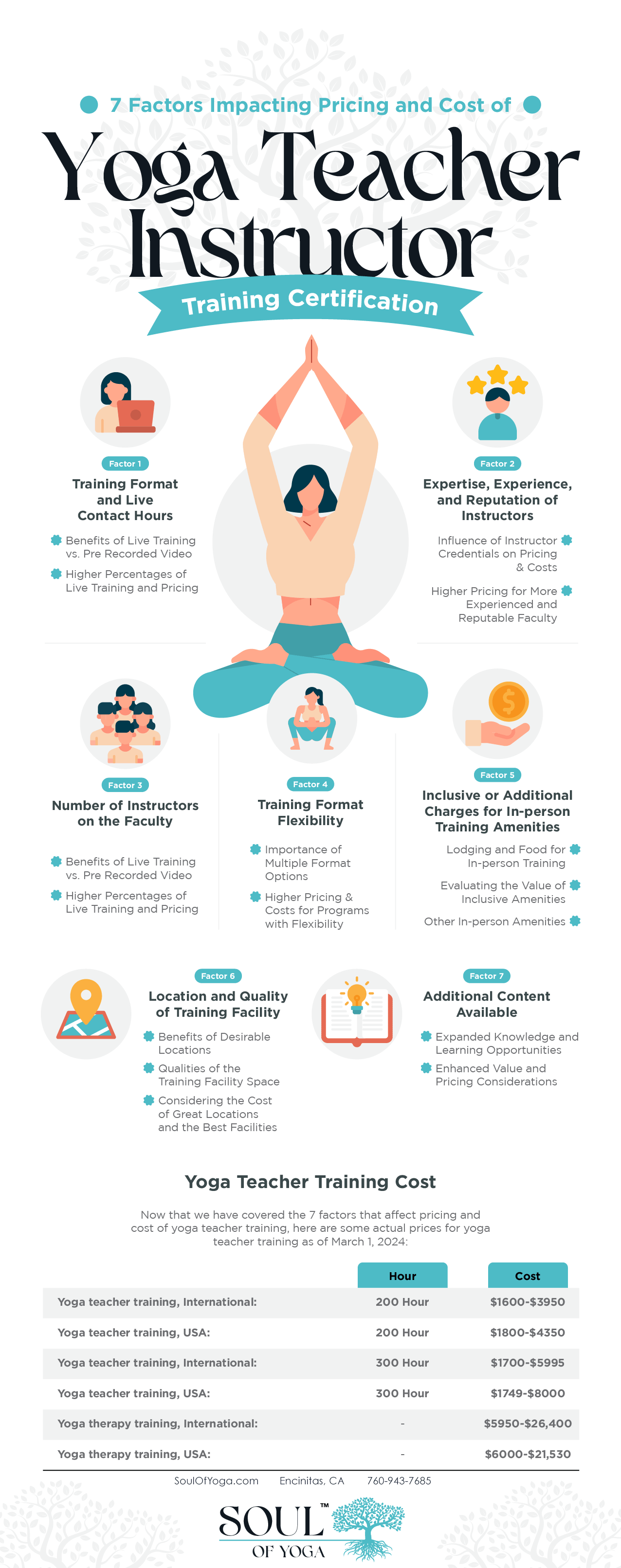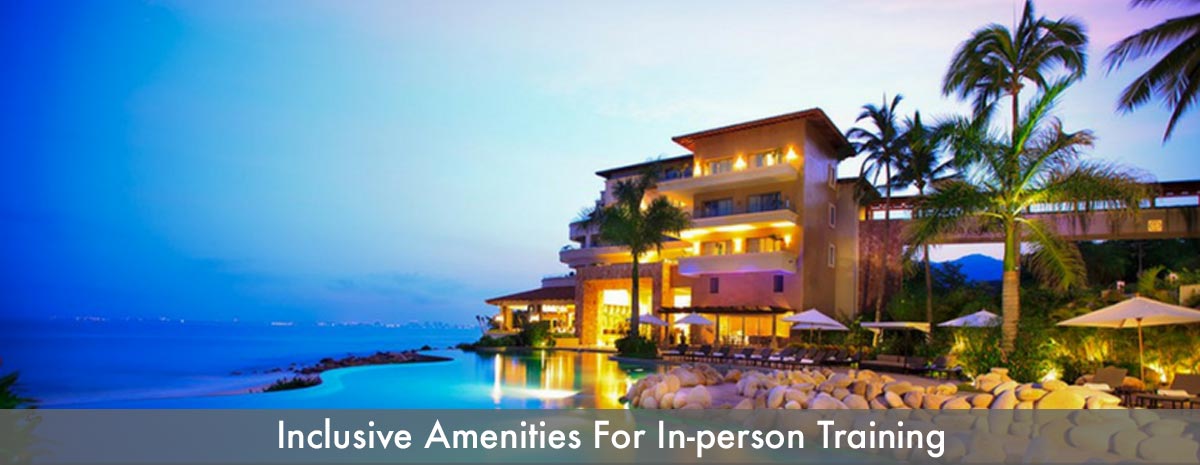7 Factors Impacting Pricing & Cost of Yoga Teacher Training & Instructor Certification
Embarking on a yoga teacher training & instructor certification is a transformative journey—one that demands thoughtful deliberation. As wisdom keepers of the ancient art of yoga and seasoned yoga teacher trainers with over two decades of experience in providing yoga teacher training, we’ve distilled our wisdom into this comprehensive guide. Our mission? To illuminate the seven pivotal factors that wield influence over the pricing and cost of yoga teacher training programs.
By unraveling these factors and discerning their hierarchy of impact on pricing, you’ll empower yourself to make informed decisions aligned with your unique criteria and select the yoga teacher training program that best fits your circumstances, finances, and personal training preferences. Enjoy your journey to becoming the yogi you have always aspired to be!
Table of Content:
Factor 1: Training Format and Live Contact Hours
- Benefits of Live Training vs. Pre Recorded Video
- Higher Percentages of Live Training and Pricing
Factor 2: Expertise, Experience, and Reputation of Instructors
- Influence of Instructor Credentials on Pricing & Costs
- Higher Pricing for More Experienced and Reputable Faculty
Factor 3: Number of Instructors on the Faculty
- Exposure to Many Instructors vs Single Teacher or Smaller Faculty
- Impact of Faculty Size and Instructor Diversity on Pricing
Factor 4: Training Format Flexibility
- Importance of Multiple Format Options
- Higher Pricing & Costs for Programs with Flexibility
Factor 5: Inclusive or Additional Charges for In-person Training Amenities
- Lodging and Food for In-person Training
- Other In-person Amenities
- Evaluating the Value of Inclusive Amenities
Factor 6: Location and Quality of Training Facility
- Benefits of Desirable Locations
- Qualities of the Training Facility Space
- Considering the Cost of Great Locations and the Best Facilities
Factor 7: Additional Content Available
- Expanded Knowledge and Learning Opportunities
- Enhanced Value and Pricing Considerations
Price Table: Yoga Teacher Training Cost
Factor 1: Training Format and Live Contact Hours
The amount of live contact hours in a yoga teacher training program plays a significant role in determining the pricing of the program. This factor focuses on the balance between pre-recorded video content and live interaction with instructors during the training.
- Benefits of Live Training vs. Pre Recorded Video:
Live training offers invaluable opportunities for students to receive personalized guidance, immediate feedback, and real-time interaction with instructors and fellow trainees. It allows for deeper learning, clarification of concepts, and the development of teaching skills through hands-on experience. Live contact hours also provide a supportive environment for students to ask questions, engage in discussions, and build meaningful connections within the yoga community.
On the other hand, pre-recorded video content can enhance the learning experience by providing flexibility and convenience. It allows students to revisit lessons, practice sequences at their own pace, and accommodate their schedules. These videos can serve as supplementary resources to reinforce concepts learned during live training sessions.
- Cost of Live Training vs Pre-Recorded Video:
Yoga teacher training programs that offer a higher percentage of live training hours generally come with a higher price tag. This is because live interaction requires the presence and availability of experienced instructors, who invest their time, expertise, and personalized attention to guide and support trainees throughout the training process. Furthermore, live training requires additional attention to ensure effective learning. Additional logistical arrangements may be required, such as securing suitable training spaces, maintaining an optimal student-to-instructor ratio, and organizing logistics for in-person or virtual sessions. All of these factors contribute to the overall cost of the program.
It is important to note that while live training is often considered the gold standard for effective learning in yoga teacher training, the balance between live and pre-recorded content can vary. Some programs may have a greater emphasis on live training, while others may offer a more blended approach. In some cases, the program may be nearly, or entirely, all pre-recorded. The pricing will reflect the proportion of live contact hours and the associated costs incurred by the training provider.
When considering the training format and live contact hours, you should assess your preferred learning style, availability, and budget. If you value direct guidance, interactive learning, and personalized feedback, opt for programs with a higher percentage of live training, even if they come at a higher cost. Conversely, for individuals with scheduling constraints or a preference for self-paced learning might find programs with a more flexible blend of pre-recorded videos and live sessions to be a better fit.
Factor 2: Expertise, Experience, and Reputation of Instructors
The expertise, experience, and reputation of the instructors on the faculty of a yoga teacher training program all have a significant impact on the pricing of the program. This important factor highlights the value placed on the qualifications and standing of the instructors who share their wisdom, as well as guide and mentor students throughout their yoga journey.
- Influence of Instructor Credentials on Pricing:
Highly qualified and experienced yoga instructors bring a wealth of knowledge, skills, and insights to the training program. They possess advanced certifications, extensive teaching experience, and a deep understanding of various yoga styles, philosophies, and techniques. Their expertise enables them to provide comprehensive and well-rounded training, ensuring that trainees receive the highest quality education.
Yoga instructors with notable recognition or credentials, such as authors of well known books, teachers who are well known in the yoga community and have a large national or international following, and those who have highly specialized knowledge and/or high levels of education, often command higher fees. Their presence on the faculty adds credibility and enhances the value of the training program. Students recognize the benefit of learning from instructors who have established themselves as an expert in the field or who are reputable figures within the yoga community.
- Higher Pricing for More Experienced and Reputable Faculty:
The experience of instructors plays a crucial role in shaping the pricing of yoga teacher training programs. Instructors with extensive teaching experience have honed their skills through years of practice and can offer valuable insights and guidance to students. Their expertise allows them to address a wide range of student needs, adapt to different teaching environments, and provide mentorship that extends beyond the training program. The prestige associated with such instructors can result in higher pricing for the training program, as the program providers will often pay higher rates for these instructors to remain on faculty of the program.
All of our instructors are experienced, very knowledgeable and have built a strong reputation within the yoga community. Many are recognized for published works or leading experts in their respective area of focus. All yoga teacher students will benefit from the depth of knowledge and guidance provided by our many experienced instructors who have extensive experience and strong reputation.
Factor 3: Number of Instructors on the Faculty
Multiple instructors provide diverse perspectives and unique expertise, enhancing the overall quality and training experience for students. Imagine learning from over a dozen instructors, each a true master in their area, how amazing would that be?
- Exposure to Many Instructors vs Single Teacher or Smaller Faculty:
Programs that have a larger number of instructors offer students the opportunity to learn from a diverse range of perspectives, teaching styles, and areas of expertise. Each instructor brings their unique insights, experiences, and specialties to the training, enriching the learning journey for the students.
Access to multiple instructors allows students to receive a well-rounded education and gain exposure to different teaching methodologies and approaches. This exposure fosters a broader understanding of yoga and its various aspects, empowering students to develop their own teaching style and adaptability in their future yoga careers.
- Impact of Faculty Size and Instructor Diversity on Pricing:
Yoga teacher training programs that feature a larger faculty typically offer more variety in terms of teaching styles, specialties, and areas of expertise. This diversity can be attractive to students seeking an in-depth, yet comprehensive and well-rounded training experience.
Our training has always offered diverse perspectives and teachings from a variety of world-class instructors, giving students exposure to diverse perspectives, teaching styles, and areas of expertise – enhancing the overall learning experience. That is why we offer classes from over a dozen instructors, each a true master in their area, for a truly amazing learning experience.
The Soul Institute has 15+ master teachers in the 200 Yoga Teacher Training Program, making our YTT the broadest and deepest in terms of quality and quantity of teachers of any 200 TYY program available, worldwide.
Factor 4: Training Format Flexibility
The flexibility of the training format refers to the options and variations available in terms of flexible attendance options for yoga teacher training: in-person and online attendance, live and recorded videos, and makeup options for missed time.
- Importance of Multiple Format Options:
Flexibility in training format allows you to choose a program that aligns with your individual needs, preferences, and constraints. Not everyone can commit to a full-time, immersive training program that requires extensive time and dedication. Offering multiple format options accommodates a wider range of students, making the program more accessible and attractive to potential participants.
The most flexible programs offer students the ability to choose day to day between: attending in-person, live online, or recordings of the live sessions later.
Often, it is most desirable to attend in-person, but life events, illness, or the Covid pandemic may suddenly make it better to continue either online or by accessing recordings later.
Programs with flexibility in attendance options allow you to continue work towards your goals without having to try to reschedule to later time. Programs that provide diverse format options can include full-time or part-time schedules, intensive or extended durations, and in-person or online components. This flexibility allows you to tailor your training to fit your existing commitments, work schedules, and personal circumstances. It allows you to strike a balance between your yoga education and other responsibilities while ensuring that unexpected situations will not get in the way of your progress.
- Higher Pricing for Programs with Flexibility:
Yoga teacher training programs that offer greater flexibility in format often require additional resources. These additional resources and accommodations can contribute to higher overall costs, which are reflected in the pricing of the program.
Student students who prioritize the ability to adapt their training around their personal lives may be willing to pay a premium for the convenience and flexibility offered by these programs. The increased pricing reflects the added value of accommodating individual needs and providing options that enhance the overall learning experience.
When considering the training format flexibility, evaluate your personal circumstances, time availability, and learning preferences. Those with greater scheduling flexibility and more certainty in their personal circumstances may find programs with more rigid formats to be a better fit, while others may prioritize the convenience and customization of flexible options, even at a higher cost.
Factor 5: Inclusive or Additional Charges for In-person Training Amenities
When considering a yoga teacher training program, it’s important to take into account the impact of lodging, food, and amenities on pricing as these can significantly influence the overall cost of the training and the experience you will have. Some programs offer lodging, food, or other amenities at no additional cost, while others offer options at additional costs, or allow you to choose and pay separately for these items. Let’s dive into the impact of lodging, food, and other amenities on pricing.
- Lodging and Food for In-person Training:
Some destination based yoga teacher training programs provide accommodation options for participants. The type of lodging offered can vary, ranging from shared dormitories or simple rooms to private accommodations or more luxurious settings. The quality and location of the lodging affects the overall pricing of the program. Generally, programs that offer higher-end accommodations or are located in popular tourist destinations have higher costs, while those with more basic accommodations or in less sought-after areas are more affordable.
Some yoga teacher training programs include meals as part of the package. The type and quality of food provided can vary from simple vegetarian or vegan meals to gourmet organic options. Programs that offer specialized diets or cater to specific dietary needs often have higher costs. If meals are not included, you will need to add the expenses of dining out or preparing your own meals during the training.
- Other In-person Amenities:
Inclusive amenities may also extend beyond the training spaces. Some programs offer additional services and resources to support trainees throughout their training journey. This can include access to libraries or online resources with a wide range of yoga books, research materials, and teaching resources. Trainees may also have the opportunity to consult with experienced instructors outside of regular training hours for personalized guidance and mentorship.
Additionally, programs that provide inclusive amenities may offer supplementary workshops, guest lectures, or specialized training sessions led by renowned yoga experts or professionals in related fields. These additional offerings broaden the trainees’ knowledge, expose them to different perspectives, and enhance the overall value of the training program.
- Evaluating the Value of Inclusive Amenities:
The amenities available during the yoga teacher training can also impact pricing. Some programs may include additional features such as access to a swimming pool, spa services, yoga props and equipment, meditation spaces, or outdoor facilities. These amenities can contribute to a more comfortable and enjoyable experience but may come at an additional cost. It’s important to assess which amenities are important to you and whether they align with your preferences and budget.
Factor 6: Location and Quality of Training Facility
The location and quality of the training facility are important factors that can impact the cost of a yoga teacher training program, specifically the physical environment and amenities available at the training facility.
- Benefits of Location:
The location of the training facility plays a crucial role in determining the pricing of the program. Training programs situated in popular or sought-after destinations, such as picturesque natural settings, recognized spiritual areas, serene retreat centers, locations with desirable climate, or vibrant urban areas, may command higher prices. The appeal of a desirable location lies in the potential for a more immersive and inspiring training experience, surrounded by a conducive environment that enhances the overall learning journey.
A desirable location can offer students access to towns with meaningful activities, natural beauty, tranquility, or cultural experiences that complement the practice of yoga. It may also provide opportunities outside of training for outdoor sessions, hikes, trips to the beach, or other recreational activities. The added value of a desirable location can increase the cost of the program for the unique experience and ambiance it offers.
- Qualities of the Training Facility Space:
The quality of the training facility itself, including the infrastructure, amenities, and services provided, is another crucial factor in determining the program cost. A well-maintained facility with modern amenities, comfortable practice spaces, clean and well-equipped restrooms, and appropriate lighting and ventilation can contribute to a positive learning experience.
High-quality training facilities often invest in creating a conducive environment for learning and personal growth. This can include features such as dedicated yoga studios, meditation rooms, relaxation areas, and access to wellness facilities like spas or saunas. The availability of such amenities adds value to the program and may result in higher cost.
- Considering the Cost of Great Locations and the Best Facilities:
When considering the location and quality of the training facility, you should assess the importance you place on the environment in which they will undertake your training. students seeking a serene and inspiring atmosphere or access to specific amenities may find programs in desirable locations or with high-quality facilities to be more appealing, even if they come at a higher price tag. Others may prioritize the quality of the instruction over the physical environment and amenities, opting for more affordable options.
In summary, desirable locations and high-quality training facilities can enhance the overall learning experience, offering unique settings and amenities that contribute to a positive and immersive training journey.
Factor 7: Additional Content Available
The availability of supplementary content in a yoga teacher training program, including textbooks, manuals, printed materials, workshops, and extra live hours, can influence the pricing of the program. Let’s dive into these value-added resources and experiences that go beyond the minimum requirements for Registered Yoga Teacher (RYT) certification from Yoga Alliance.
- Expanded Knowledge and Learning Opportunities:
Yoga teacher training programs that include additional content beyond the basic certification curriculum provide student students with opportunities to deepen their knowledge and expand their understanding of yoga. This can include supplementary textbooks, manuals, or printed materials that cover a wide range of topics related to yoga philosophy, anatomy, sequencing, meditation, or specialized teaching methodologies. These resources enable you to delve deeper into specific areas of interest and enhance your overall teaching skills.
Furthermore, workshops or extra live hours offered as part of the program, can provide valuable experiential learning opportunities. These additional sessions may focus on advanced asanas, hands-on adjustments, teaching special populations, supplemental skills like marketing, or specialized yoga styles. The inclusion of such workshops or live experiences broadens the students’ repertoire of teaching techniques and enriches their learning journey.
- Enhanced Value and Pricing Considerations:
The availability of additional content in a yoga teacher training program adds value to the overall learning experience and contributes to the pricing structure. The costs associated with developing or sourcing high-quality textbooks, manuals, and printed materials, as well as organizing and conducting supplementary workshops or live sessions, are factored into the program fees.
You should assess the importance you place on the availability of additional content and experiences when considering the pricing of a program. The value of these resources lies in the opportunity to expand knowledge beyond the minimum certification requirements and gain a deeper understanding of yoga as a whole. The inclusion of such content justifies a higher price, as it provides students with a more comprehensive and enriched learning experience.
It is crucial for you to evaluate your own learning goals and preferences. Those seeking to broaden their understanding, explore specialized topics, or gain exposure to different teaching approaches may find programs with additional content and experiences more appealing, even at a higher cost. Others, who prioritize the certification requirements and have limited interest in supplementary materials or workshops may opt for more affordable options.
As you embark on your yoga teacher training journey, consider your goals, circumstances, finances, and personal training preferences. Ask yourself: how do they line up with the 7 factors and where do I place the most importance? These will be your personal guiding principles as you navigate the part of your journey.
To expedite your journey, we’ve thoroughly researched the most popular, accessible, and reputable yoga teacher training programs in the world. Below, you’ll find a summary of the costs and included amenities for each program.
Yoga Teacher Training Cost
Now that we have covered the 7 factors that affect pricing and cost of yoga teacher training, here are some actual prices for yoga teacher training as of March 1, 2024:
-
200 Hour yoga teacher training, International: $1600-$3950
-
200 Hour yoga teacher training, USA: $1800-$4350
-
300 Hour yoga teacher training, International: $1700-$5995
-
300 Hour yoga teacher training, USA: $1749-$8000
-
Yoga therapy training, International: $5950-$$26,400
-
Yoga therapy training, USA: $6000-$$21,530
With our extensive experience spanning over twenty years providing yoga teacher training, we, as keepers of the ancient yogic wisdom and seasoned practitioners, have condensed our knowledge into this comprehensive guide to help you on your yogic journey. We are excited for you to continue your yoga journey, wherever it may lead. If you are interested in training with the world’s premier yoga institute, fill out the form below for more info and we will be in touch.






